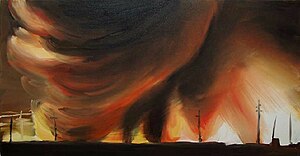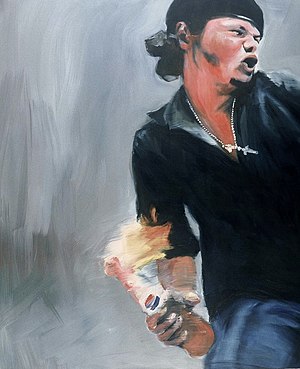Joy Garnett
| Plume 2 (Strange Weather) | |
|---|---|
 |
|
| Artist | Joy Garnett |
| Year | 2005 |
| Medium | Oil on canvas |
| Dimensions | 66 cm × 117 cm (26 in × 46 in) |
| Location | Courtesy of the National Academy of Sciences, Washington, DC |
| Molotov | |
|---|---|
 |
|
| Artist | Joy Garnett |
| Year | 2003 |
| Medium | Oil on canvas |
| Dimensions | 178 cm × 152 cm (70 in × 60 in) |
| Location | Private Collection |
Joy Garnett (born 1965 ) is a painter and writer in Brooklyn, New York, United States. Garnett's paintings, based on photographs and technical imagery, examine the intersections of media, politics and culture. She engages contemporary consumption of media and the delineation between journalistic and artistic images. She is married to visual artist Bill Jones.
From 2005 to 2016, Garnett was Arts Editor at Cultural Politics, a contemporary culture, politics and media journal published by Duke University Press. She is the founding editor of NEWSgrist.
Controversy surrounding her 2003 painting Molotov has drawn international scrutiny to issues of ownership and fair use.
In 2004, Garnett received an Anonymous Was A Woman Award.
Garnett completed her undergraduate work at McGill University in Quebec, Canada in 1983. In 1984 she went to Paris to study painting, and in 1985 she enrolled at École Nationale Supérieure des Beaux-Arts. She returned to New York in 1987 and began work at Watanabe Studio, Ltd. in Brooklyn, NY. In 1989 she entered the graduate program at The City College of New York; she received her MFA in 1991. While attending City College, Garnett received the Elizabeth Ralston McCabe Connor Award.
After graduating, her work was exhibited in several group shows, including the Summer Show at Debs & Co., New York in 1999. Debs & Co. also hosted her first solo exhibition the following spring, entitled "Buster-Jangle", a collection of paintings that appropriated photos of atomic bomb tests from the 1950s that Garnett found on the web after they were released by the US government under the Freedom of Information Act. Her work was reviewed and noted for its exploration of a “paradoxical realm of terrible beauty… tying together the histories of the bomb and American landscape painting."
In 1997, while doing research for her first solo exhibition, Garnett began gathering images and documents about nuclear testing from primary sources on the Internet. Eventually this resulted in an online compilation of material known as The Bomb Project. Spawned from her extensive imagery search, it led to an experimental recontextualization of images in a constantly growing archive. In creating The Bomb Project, Garnett addresses the role of the digital image as a cultural artifact, and attempts to reveal the information and hegemonic coding within these images with as little intervention as possible. She seeks to “establish a context where art, science and government are presented as interlocking and overlapping areas.” Since its launch in 2000, the Bomb Project has been expanded to include still and moving declassified imagery, as well primary source documents, links to current events and news articles. The original documentation, produced by the nuclear industry, is offered side by side with activist views, providing a context for comparative study, analysis and creativity. In its current form, the compendium is intended to be used as a resource for other artists.
...
Wikipedia
